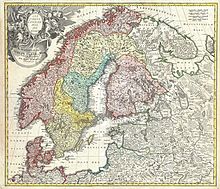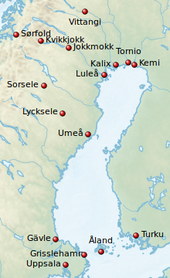Expedition to Lapland


The expedition to Lapland was a research trip by Carl von Linné in 1732 to Lapland, the northernmost region in Sweden . The expedition was an important part of his scientific career.
Linnaeus started in Uppsala and traveled clockwise around the coast of the Gulf of Bothnia in six months . From Umeå , Luleå and Tornio he went on long excursions inland. His observations became the basis of his book Flora Lapponica (1737), in which Linnaeus' ideas about nomenclature and classification were first put into practice. Linné kept a journal of his expedition, which appeared for the first time in English translation after his death in 1811 under the title Lachesis Lapponica: A Tour in Lapland .
background
In April 1732 Linnaeus received a grant from the Royal Society of Sciences in Uppsala for his trip . Olof Rudbeck the Younger , one of Linnaeus' previous professors at Uppsala University , had embarked on an expedition to Lapland in 1695 . But the detailed results of his exploration were destroyed by fire seven years later. Linnaeus' hope was to find new plants, animals and minerals. He was also curious about the customs of the Sami , reindeer-herding nomads who roamed the vast tundras of Scandinavia .
From Uppsala to Umeå
Linnaeus started his expedition in Uppsala in May . He traveled on foot and on horseback. In his luggage he had his journal, botanical and ornithological manuscripts as well as leaves for pressing plants. Linnaeus took eleven days to reach Umeå via Gävle . In the vicinity he found large quantities of Campanula serpyllifolia . This later became known as Linnaea borealis (moss bell), the twin flower that became his favorite plant. Sometimes he left the path to examine a flower or a rock. He was particularly interested in deciduous mosses and lichens . The latter are an essential part of the diet of reindeer , a common animal in Lapland.
First inland excursion
From Umeå, Linnaeus went to Lycksele . The city was deeper inland than he had previously advanced. On the way he observed water birds. After five days he reached the city and stayed with the pastor and his wife. Then Linné tried to reach Sorsele . But he had to turn back because of extremely difficult conditions at a place called Lycksmyran ("Swamp of Fortune"). He returned to Umeå in early June after spending more days in Lycksele learning more about Sami customs.
From Umeå to Luleå and second inland excursion
After his return to Umeå, he traveled further north along the coast of the Gulf of Bothnia , via Skellefteå and Alt Piteå , past Alt Luleå , where he was given a Sami women's cap on the way. From Luleå he traveled back inland. He followed the Lule River and traveled via Jokkmokk to the Arctic Circle and to Kvikkjokk (now Hyttan), into the Scandinavian Mountains and across the border to Norway. Linné reached the coast in Sørfold and made a detour to nearby Rørstad. Then he traveled back the way he had come, about 300 kilometers to Luleå.
From Luleå to Tornio, the third inland excursion and return to Uppsala
Linnaeus then continued his journey along the coast to Tornio ( Torneå in Swedish ). From there he made his third and last inland excursion, along the Torne älv river to Vittangi . He spent some time in the Tornio area. In Kalix, Linnaeus learned assaying . In mid-September he started his return journey. Linnaeus traveled via Kemi and then followed the Finnish coastline to Turku ( Åbo in Swedish ). From there he sailed across the Åland Islands to Sweden, which he reached in Grisslehamn . The last stage brought Linné home to Uppsala.
Results
Linnaeus came back on October 10, 1732 from a six month long, over 2,000 kilometer expedition on which he had examined many plants, birds and minerals. Although Lapland is a region with limited biodiversity , Linnaeus described over a hundred previously undescribed plants. The details of his discoveries formed the basis of his book Flora Lapponica .
Linné's travelogue Iter Lapponicum was translated into English by James Edward Smith and published in 1811 as Lachesis Lapponica: A Tour in Lapland .
- Some of Linné's original illustrations
The mythological Andromeda and the plant he named after her
literature
- Margaret J. Anderson: Carl Linnaeus: father of classification . Enslow Publishers, United States 1997, ISBN 978-0-89490-786-9 (English).
- Wilfrid Blunt: Linnaeus: the compleat naturalist . Frances Lincoln, London 2001, ISBN 0-7112-1841-2 (English).
- Wilfrid Blunt: Linnaeus: the compleat naturalist . Frances Lincoln, London 2004, ISBN 0-7112-2362-9 (English).
- Gunnar Broberg: Carl Linnaeus . Swedish Institute, Stockholm 2006, ISBN 91-520-0912-2 (English).
- Carl Linné: Lachesis Lapponica: A Tour in Lapland . tape I . White and Cochrane, London 1811 (English, archive.org ).
- Carl Linné: Lachesis Lapponica: A Tour in Lapland . tape II . White and Cochrane, London 1811 (English, archive.org ).
- Dietrich Johann Heinrich Stöver: The Life of Sir Charles Linnaeus . Ed .: Joseph Trapp. B. and J. White, London 1794 (English, archive.org ).
Remarks
- ↑ For a complete view of the clothes and the drum see file: Carl Linnaeus dressed as a Laplander.jpg
- ↑ Regarding the Sami drums and their religion : Blunt (2001; pp. 45, 54) recalls two anecdotes from Linnaeus' Lapland expedition: Linnaeus showed a seed some of his detailed drawings of nature; the man was troubled by the sight, took off his cap, bowed and left his head bowed in adoration and his hand on his chest, muttering to himself and shivering as if he were about to faint. That was because he thought the drawings were as magical as the drawings on the drums in his home country and Linnaeus thought they were a magician. Another time, Linnaeus was told that if a seed refused to hand over objects of its religion, such as magical drums or sacred statues, to missionaries, its cloak would be opened and it would be pressed down, after which the artery of its arm would be opened; then let it bleed until it gives in - a practice that, according to Linnaeus, has often been successful.
- ↑ In 1809 Lapland was divided between Sweden and the newly created Grand Duchy of Finland ; for information on the traditional Sami region in Norway and Russia, see Sápmi .
- ^ Map of the travel route Carl von Linnés. In: dpc.uba.uva.nl. Archived from the original on March 3, 2016 ; accessed on June 10, 2019 . from Carl von Linné: Lappländische Reise and other writings . Leipzig 1991.
Individual evidence
- ↑ Blunt (2001) pp. 41-65
- ^ David Frodin: Guide to Standard Floras of the World . 2nd Edition. Cambridge University Press, Cambridge 2002, pp. 27 (English).
- ↑ Anderson (1997) pp. 42-43
- ↑ Blunt (2001) p. 38
- ↑ a b Blunt (2001) pp. 42-43
- ↑ Anderson (1997) pp. 43-44
- ↑ Anderson (1997) p. 46
- ↑ Blunt (2001) pp. 47-51
- ↑ Blunt (2001) pp. 45-47
- ↑ Anderson (1997) pp. 50-51
- ↑ Blunt (2001) pp. 55-56
- ↑ Blunt (2001) pp. 64-65
- ↑ Blunt (2001) pp. 63-65
- ↑ Blunt (2004) pp. 39-42
- ↑ Broberg (2006) p. 29
- ↑ David Quammen: The Name Giver . In: National Geographic . June 2007 (English, archive.org ).
- ↑ Stöver (1974) pp. 38-39
- ↑ Carl von Linné: Ungdomsskrifter . Ed .: Ewald Ährling. P- A- Nordstedt & Söners, Stockholm 1889 (Swedish, archive.org ).


